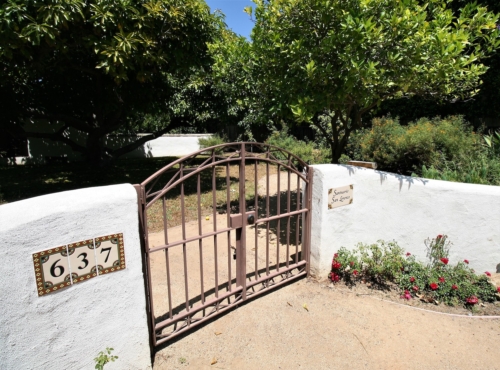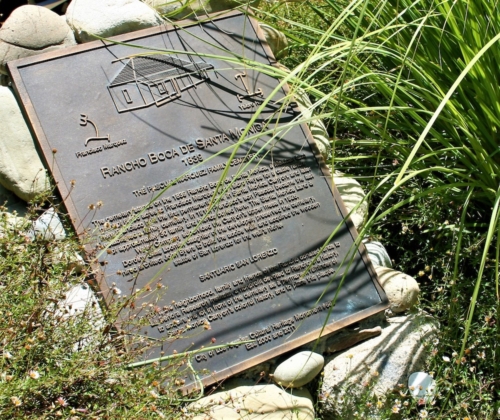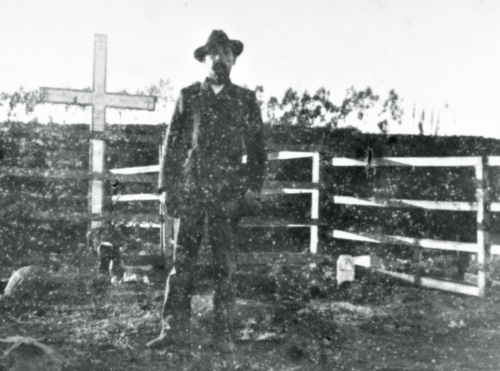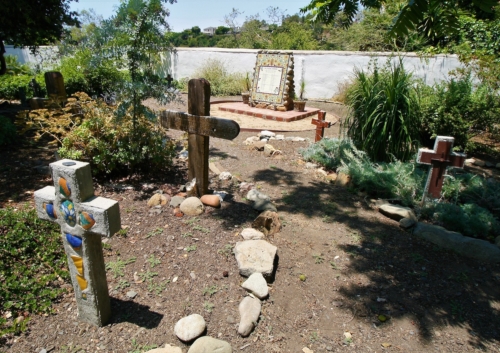Pascual Marquez Family Cemetery
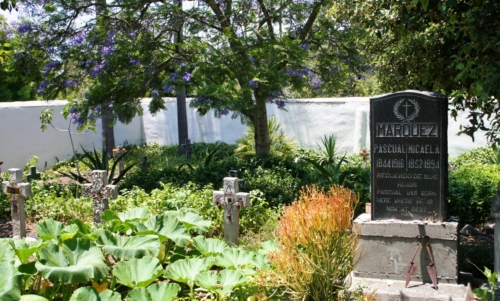
- Known As
- Rancho Boca
- Architect
- Adobe wall by John Byers (1926)
- Built
- 1840s
- Designated
- 2009
The Marquez Family Cemetery claims a hallowed place on San Lorenzo Street, an anomaly among the established affluence of this Santa Monica Canyon neighborhood.
One of the last remnants of the Boca de Santa Monica land grant, this sacred ground is home to the patrimony of a pioneering Mexican family that continues to represent the enduring spirit of California’s Rancho period.
In 1838, Francisco Marquez and Ysidro Reyes applied for title to Rancho Boca de Santa Monica, a 6,656-acre tract of land comprising what is now Santa Monica Canyon, Pacific Palisades and parts of Topanga Canyon.
Both men lived in Los Angeles and established businesses downtown. Born in Mexico, Marquez came to the city in 1820 while it was still under Spanish control. He set up a downtown blacksmith and harness shop on Calle Principal, now Main Street.
Reyes, a Los Angeles native, owned one of the largest vineyards in the area and operated a business transporting brea (tar) from the tar pits at Rancho La Brea to homes for use as roofing material.
To obtain a land grant, applicants had to be a Mexican citizen of good character and a practicing Catholic. They also had to agree to build a house and plant fruit trees on their land, as well as stock the rancho with at least 150 head of cattle. The application by Marquez and Ysidro was approved and they received title in 1839.
Marquez, his wife, Roque Valenzuela, and their son, Manuel, moved to Santa Monica Canyon, where he built an adobe house on the upper mesa — the first permanent structure built in the canyon. There, he opened another blacksmith shop and continued to live and work the rancho until his death in 1850. He and Roque had 11 children.
Reyes found a suitable location for his home on the canyon’s rim near what is now 7th Street and Adelaide Drive. Like his partner, Reyes had a big family, raising 11 children with his wife, Maria Antonia. The close relationship between the families was further sealed by the marriage of Marquez’s youngest son, Pascual, and Reyes daughter, Michaela.
While the land once occupied by Rancho Boca de Santa Monica is some of the most valuable real estate in the world, it was considered the hinterlands back in the day. Distances necessitated the rancho be completely self-sufficient, providing its own food and water – even a cemetery. The rancho was more than a day’s trip from the nearest Catholic cemeteries at the San Gabriel Mission and the Plaza Church in Los Angeles. So to ease the burden, Francisco Marquez set aside a portion of land for a family cemetery within view of his adobe house.
In 1861, Ysidro Reyes died, leaving his undivided one-half interest in the rancho to his widow, Maria, who in 1872, sold that share to Colonel Robert S. Baker for $6,000.
Baker was less interested in raising livestock than imagining a port city, which would link by railroad to Los Angeles. This was a harbinger of the drive toward the ultimate breakup of the ranchos. Property-rich but increasingly cash poor, the land grant families often had little choice but to sell their real estate at low prices to meet the expenses of a developing California.
The Marquez family members retained their share of the rancho, which was divided into three allotments – one for residential, one for grazing and a smaller portion at the mouth of Santa Monica Canyon for business use.
Pascual Marquez’s section in Santa Monica Canyon included his home, the remains of the family adobe, where he was born in 1844, and the family cemetery.
In 1894, his wife, Micaela, died and was laid to rest in the tiny graveyard, and over the years, dozens of members of the Marquez and Reyes families followed. This included 13 members who died in a tragic botulism outbreak in 1909.
In 1916, Pascual Marquez was the last person buried at the cemetery, which by this time had grown to encompass the ruins of the family adobe. His marble headstone, originally placed inside the adobe ruins, is one of only two surviving markers in the cemetery.
As residential development drove Pascual’s heirs to sell their allotments, further threatening the cemetery, the Marquez family decided in 1926 that the cemetery should be preserved and protected.
At the same time, Dorothy Gillis Loomis, daughter of Robert Gillis, commissioned renowned architect John Byers to design a wall around the perimeter of the cemetery. A statue of San Lorenzo embedded in a niche in the wall remains to this day.
Through the decades, descendants of the family continued to oversee and maintain the cemetery, which became the rear portion of a lot at 637 San Lorenzo Street, and they do so to this day.
While there was a 4-foot-wide easement running down the center of the front lot to the cemetery entrance, the front lot itself was threatened with the construction of a new house in 2009. Concern that this front property might contain more buried remains prompted a call to action.
Neighbors rallied, and with a robust fundraiser, supporters bought the access parts of the land in front of the cemetery, thus saving a resting place that has been cared for by the family for more than 160 years. The cemetery was designated by the City of Los Angeles as Historic Cultural Monument #685 in 2000. In 2011, the north portion of the surrounding lot was added to the Monument during the dispute over construction of the new house on the south portion of the lot. That north portion is now known as the Santuario San Lorenzo and serves as the entrance to the cemetery. The addition to the Monument solved the easement issues that had bedeviled the site for over twenty years.
The cemetery graves, which were located through electronic imaging, are now marked with hand-crafted crosses made by the grandson of Pascual Marquez, Ernest Marquez, who has dedicated his life to preserving the history of his family’s beloved Boca de Santa Monica Rancho.
Sources:
Barron, Art. “Saving a Sacred Rancho in the Canyon.”
Scott, Paula. Santa Monica: A History on the Edge.
Pascual Marquez Family Cemetery: History of the Marquez and Reyes Family.
